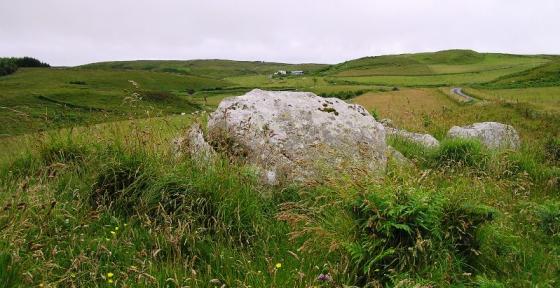
Visited 08 August 2011ce
Larger cup with “pestle” removed to reveal community of red ants living underneath.

Visited 08 August 2011ce
Larger cup with “pestle” removed to reveal community of red ants living underneath.

Visited 08 August 2011ce
Larger “pestleated” cup.

Visited 08 August 2011ce
Smaller cup with “pestle” removed (then carefully replaced!).

Visited 08 August 2011ce
Smaller “pestleated” cup.

Visited 08 August 2011ce

Visited 08 August 2011ce

Visited 08 August 2011ce
Panel with “pestles” in two largest cups.

Visited 08 August 2011ce
Location of panel in relation to chapel.

This can be found on the floor just outside the ruined chapel. Is it authenic? I don’t know but its a holed stone and those sure look like cup marks to me
Visited 30.7.16
Directions:
Next to the ruined St Ciaron’s Church which is alongside the minor road north of Portnahaven. The church is sign posted and parking is easy enough.
Even by Islay standards this is pretty remote.
I like old churches and this is a lovely, ruined old church situated in a lovely spot overlooking Kilchiaran Bay. The fact it has a cup marked stone immediately next to it obviously adds to its attraction!
The various cup marks are of different sizes and depths. The largest one has worn right through the stone.
It’s a nice enough stone and worth stopping off for however I must say the church was my biggest thrill. Inside and overgrown were several medieval grave stones. The rocky shore of Kilchiaran Bay only a short distance away. No doubt this must have been a place of pilgrimage. It is a very atmospheric place and one I would highly recommend visiting.
From the information on Canmore:
“A cup marked and perforated slab lies in rough grass 20yds WSW of St Ciaron’s Chapel and 20yds N of the road. The slab is of schist 6ft by 3ft with a thickness of 6ins exposed, the rest being buried. Graham noted 22 cups in 1895 but only 18 are now visible, 6 1/2 ins in maximum diameter and 4 ins deep, clearly man-made but some having vertical sides. Two cups have penetrated the slab completely.”
The local tradition is that church-goers turned a pestle in any cup-mark and wished. The constant turning wore the cups, “in some cases right through the stone”.
A similar ritual is done with cups in the base of a cross at nearby Kilchoman (NR215632). According to the source used by Kevin Callahan in his article on rock art here:
tc.umn.edu/~call0031/folklore.html
it was still being used 1968 – the pestle would be turned 3 times sunwise, and a coin left. The cup was full of pennies and the church officer collected them up periodically.
But this cupped base just looks too neat and new.
rcahms.gov.uk/pls/portal/newcanmore.p_coll_details?p_arcnumlink=416799
Was it a ritual adopted from the (presumably)older Kilchiaran?





























